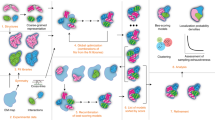Abstract
Based on the molecular electron density lego assembler (MEDLA) method, a “computational microscope” was developed that generates accurate images of bodies of large molecules at a resolution far exceeding current experimental techniques. The MEDLA “microscope” can be “tuned” to display the high electron density regions of formal chemical bonds; or to show the low density regions of hydrogen bonds and secondary interactions, or to display local shape requirements important in molecular recognition. The power of the method is illustrated by examples of detailed images of taxol, an important anti-cancer agent, and HIV-1 protease, a protein of 1564 atoms. A mathematical framework of the approach, based on fuzzy sets, and the fundamentals of several additional applications of the additive, fuzzy fragmentation principle are presented.
Similar content being viewed by others
References
P.G. Mezey,Shape in Chemistry: An Introduction to Molecular Shape and Topology (VCH Publ., NewYork, 1993).
P.D. Walker and P.G. Mezey, J. Amer. Chem. Soc. 115 (1993)12423.
P.D. Walker and P.G. Mezey,Program MEDLA 93 (Mathematical Chemistry Research Unit, University of Saskatchewan, Saskatoon, Canada, 1993).
P.D. Walker and P.G. Mezey, J. Amer. Chem. Soc. 116 (1994)12022.
P.D. Walker and P.G. Mezey, Canad. J. Chem. 72 (1994)2531.
P.D. Walker and P.G. Mezey, J. Comput. Chem., in press.
P.G. Mezey, Int. J. Quant. Chem. Quant. Biol. Symp. 14 (1987)127.
K.C. Nicolau, Z. Yang, J.J. Liu, H. Ueno, P.G. mNantermet, R.K. Guy, C.F. Claiborne, J. Renaud, E.A. Couladouros, K. Paulvannan and E.J. Sorensen, Nature 367 (1994)630.
R.A. Holton, C. Somoza, H.-B. Kim, F. Liang, R.J. Biediger, P.D. Boatman, M. Shindo, C.C. Smith, SKim, H. Nadizadeh, Y. Suzuki, C. Tao, P. Vu, S. Tang, P. Zhang, K.K. Murthi, L.N. Gentile and J.H. Liu, J. Amer. Chem. Soc. 116 (1994)1597.
R.A. Holton, H.-B. Kim, C. Somoza, F. Liang, R.J. Biediger, P.D. Boatman, M. Shindo, C.C. Smith, S. Kim, H. Nadizadeh, Y. Suzuki, C. Tao, P. Vu, S. Tang, P. Zhang, K.K. Murthi, L.N. Gentile and J.H. Liu, J. Amer. Chem. Soc. 116 (1994)1599.
Program BIOGRAF(Biodesign, Inc., 199 S. Los Robles Ave., Pasadena, CA 91101,1988).
S. Spinelli, Q.Z. Liu, P.M. Alzari, P.H. Hirel and R.J. Poljak, Biochimie 73 (1991)1391 (BPDB 15-OCT-92 I HHP).
R.F.W. Bader and T.T. Nguyen-bang, Adv. Quant. Chem. 14 (1981)63.
R.F.W. Bader, Arc. Chem. Res. 9 (1985)18.
C. Chang and R.F.W. Bader, J. Phys. Chem. 96 (1992)1654.
P.G. Mezey, Methods of molecular shape-similarity analysis and topological shape design, in:Molecular Similarity in Drug Design, ed. P.M. Dean (Chapman & Hall-Blackie Publ., Glasgow, UK, 1995).
P.G. Mezey, Canad. J. Chem. 72 (1994)928.
P.D. Walker and P.G. Mezey, to be published.
J. Karle, Proc. Natl. Acad. Sci. USA 88 (1991)10099.
K. Fukui,Proc. 5th IFCSymp., Institute for Fundamental Chemistry, Kyoto, 1989.
S. Arimoto, K. Fukui, K.F. Taylor and P.G. Mezey, Int. J. Quant. Chem. 53 (1995)375.
S. Arimoto, K. Fukui, K.F. Taylor and P.G. Mezey, Int. J. Quant. Chem. 53 (1995)387.
Author information
Authors and Affiliations
Rights and permissions
About this article
Cite this article
Walker, P.D., Mezey, P.G. A new computational microscope for molecules: High resolution MEDLA images of taxol and HIV-1 protease, using additive electron density fragmentation principles and fuzzy set methods. J Math Chem 17, 203–234 (1995). https://doi.org/10.1007/BF01164848
Received:
Issue Date:
DOI: https://doi.org/10.1007/BF01164848




